Laundry Cleaning Product Market
Laundry Cleaning Product Market Size and Share Forecast Outlook 2025 to 2035
The laundry cleaning product market is projected to grow from USD 98.0 billion in 2025 to USD 131.7 billion by 2035, at a CAGR of 3.0%. Liquids will dominate with a 46.0% market share, while household will lead the usage type segment with a 82.0% share.
Laundry Cleaning Product Market Forecast and Outlook 2025 to 2035
The global laundry cleaning product market is projected to reach USD 132.0 billion by 2035, recording an absolute increase of USD 34.0 billion over the forecast period. The market is valued at USD 98.0 billion in 2025 and is set to rise at a CAGR of 3.0% during the assessment period.
The market is expected to grow by nearly 1.3 times during the same period, supported by increasing global urbanization and rising hygiene awareness worldwide, driving demand for convenient laundry solutions and growing adoption of premium and eco-friendly formulations across developed and emerging markets globally. However, economic pressures affecting consumer spending and market saturation in developed regions may pose challenges to accelerated market expansion.
Quick Stats for Laundry Cleaning Product Market
- Laundry Cleaning Product Market Value (2025): USD 98.0 billion
- Laundry Cleaning Product Market Forecast Value (2035): USD 132.0 billion
- Laundry Cleaning Product Market Forecast CAGR: 3.0%
- Leading Format Type in Laundry Cleaning Product Market: Liquid Products
- Key Growth Regions in Laundry Cleaning Product Market: Asia-Pacific, North America, and Europe
- Top Key Players in Laundry Cleaning Product Market: Procter & Gamble, Unilever, Henkel, Church & Dwight, Kao, Reckitt, Fabuloso/Colgate, LG H&H, Godrej, Lion
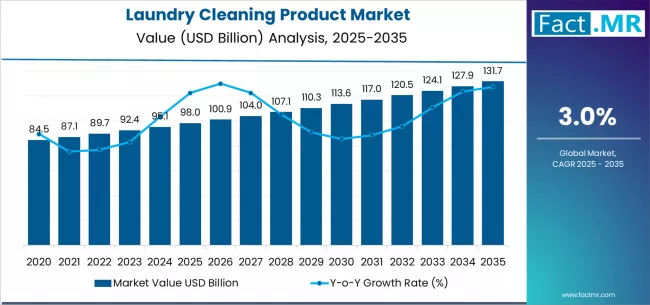
Between 2025 and 2030, the laundry cleaning product market is projected to expand from USD 98.0 billion to USD 114.5 billion, resulting in a value increase of USD 16.5 billion, which represents 48.5% of the total forecast growth for the decade. This phase of development will be shaped by rising urbanization trends and household formation growth, product innovation in concentrated formulations and sustainable packaging solutions, as well as expanding penetration in emerging markets and premium product positioning strategies. Companies are establishing competitive positions through investment in eco-friendly formulations, convenience innovations, and strategic market expansion across household and commercial laundry sectors.
From 2030 to 2035, the market is forecast to grow from USD 114.5 billion to USD 132.0 billion, adding another USD 17.5 billion, which constitutes 51.5% of the overall ten-year expansion. This period is expected to be characterized by the expansion of sustainable and concentrated laundry products, including plant-based formulations and zero-waste packaging solutions tailored for environmentally-conscious consumers, strategic collaborations between global brands and regional manufacturers, and an enhanced focus on digital commerce and subscription-based delivery models. The growing emphasis on sustainability and convenience will drive demand for comprehensive laundry solutions across diverse household and institutional applications.
Laundry Cleaning Product Market Key Takeaways
| Metric | Value |
|---|---|
| Market Value (2025) | USD 98.0 billion |
| Market Forecast Value (2035) | USD 132.0 billion |
| Forecast CAGR (2025-2035) | 3.0% |
Why is the Laundry Cleaning Product Market Growing?
The laundry cleaning product market grows by enabling households, commercial facilities, and institutional operations to maintain clothing hygiene and fabric care standards while accessing convenient and effective cleaning solutions that deliver superior cleaning performance without requiring specialized equipment or professional services.
Consumers and facility managers face mounting pressure to manage laundry efficiently and cost-effectively, with modern laundry products typically providing enhanced cleaning power, fabric protection, and convenience features that traditional soap alternatives cannot match, making advanced laundry formulations essential for effective household and commercial fabric care.
The consumer goods industry's need for convenience and cleaning efficacy creates demand for comprehensive laundry solutions that can provide reliable cleaning results, maintain fabric quality, and ensure user convenience without compromising environmental responsibility or cost-effectiveness.
Government initiatives promoting hygiene standards and household consumer product development drive adoption in developing regions and established markets, where effective laundry care has a direct impact on public health and quality of life standards.
However, economic volatility affecting consumer purchasing power and environmental regulations concerning packaging and chemical ingredients may limit premium product adoption among price-sensitive consumers and regions with strict environmental compliance requirements.
Segmental Analysis
The market is segmented by format, distribution channel, usage type, and region. By format, the market is divided into liquids, powders, pods/sheets, and others.
Based on distribution channel, the market is categorized into mass/grocery retail, online platforms, cash & carry/others.
By usage type, the market includes household and commercial/institutional. Regionally, the market is divided into Asia-Pacific, North America, Europe, and other key regions.
By Format, the Liquids Segment Accounts for a Dominant Market Share
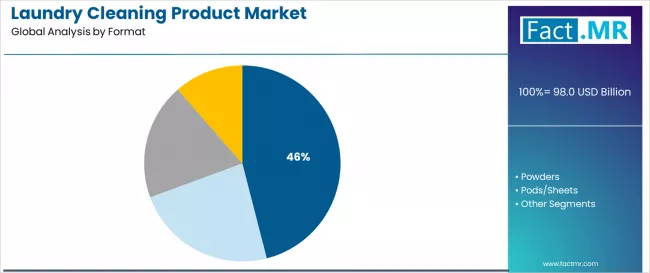
The liquids segment represents the dominant force in the laundry cleaning product market, capturing approximately 46.0% of total market share in 2025. This established format category encompasses liquid detergent formulations featuring convenient dispensing systems, enhanced fabric penetration, and superior stain removal capabilities that enable effective cleaning performance across various washing machine types and water temperatures.
The liquids segment's market leadership stems from its superior convenience capabilities, with products capable of providing precise dosing control while maintaining consistent cleaning effectiveness and user-friendly application across all household laundry requirements.
The powders segment maintains a substantial 33.0% market share, serving cost-conscious consumers and commercial applications who require bulk cleaning solutions with enhanced whitening power and economical per-load pricing for large-scale laundry operations.
These products offer cost-effective cleaning solutions for budget-focused households while providing sufficient cleaning efficacy to meet basic fabric care and commercial laundering demands. The pods/sheets segment accounts for approximately 21.0% of the market, serving convenience-focused consumers requiring pre-measured dosing and innovative packaging solutions.
Key format advantages driving the liquids segment include:
- Convenient dispensing systems with precise measurement capabilities that prevent overdosing and ensure optimal cleaning performance per wash cycle
- Enhanced fabric penetration enabling superior stain removal and cleaning effectiveness across different fabric types and soil conditions
- Temperature versatility options allowing effective cleaning in both hot and cold water washing without performance degradation
- User convenience features, reducing measuring requirements and providing consistent cleaning results for busy households
By Usage Type, the Household Segment Accounts for the Largest Market Share
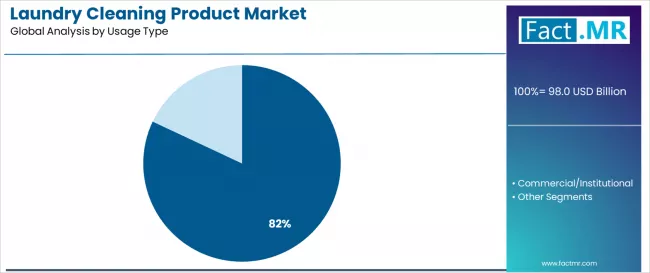
Household applications dominate the laundry cleaning product market with approximately 82.0% market share in 2025, reflecting the massive consumer base of residential laundry needs and family fabric care requirements across global household markets. The household segment's market leadership is reinforced by daily laundry washing habits, family clothing care needs, and residential washing machine penetration across developed and emerging markets worldwide.
The commercial/institutional segment represents the substantial remaining market share of 18.0% through hotels, hospitals, laundromats, and industrial laundry facilities requiring specialized formulations, bulk packaging, and professional-grade cleaning performance for high-volume laundry operations. This segment benefits from consistent demand for commercial-grade cleaning solutions that meet specific institutional hygiene requirements, operational efficiency standards, and cost-effectiveness demands in competitive commercial laundry markets.
Key market dynamics supporting usage differentiation include:
- Household expansion driven by global population growth and increasing washing machine penetration in emerging markets
- Commercial specialization enabling professional-grade formulations for high-volume institutional and commercial laundry requirements
- Market segmentation creating targeted products for residential convenience versus commercial operational efficiency
- Growing emphasis on specialized applications driving demand for household convenience products and commercial performance solutions
What are the Drivers, Restraints, and Key Trends of the Laundry Cleaning Product Market?
Global urbanization and household formation create expanding demand for convenient laundry solutions, with urban household growth expanding by 3-5% annually in major developing countries worldwide, requiring comprehensive laundry product distribution infrastructure.
Hygiene awareness and fabric care consciousness drive increased adoption of advanced laundry formulations with many consumers prioritizing premium cleaning performance and fabric protection features by 2030.
Technological improvements in formulation chemistry and packaging innovation enable more effective and convenient laundry products that deliver superior cleaning results while reducing environmental impact and enhancing user convenience.
Market restraints include economic pressures affecting consumer discretionary spending that can reduce premium product purchases, particularly during inflationary periods when household budgets face constraints.
Environmental regulations concerning packaging waste and chemical ingredients pose another significant challenge, as sustainability requirements may increase production costs and limit certain formulation options, potentially affecting competitive positioning. Market saturation in developed regions creates additional growth challenges, demanding ongoing investment in product differentiation and emerging market expansion strategies.
Key trends indicate accelerated growth in eco-friendly and concentrated products, particularly in North America and Europe, where environmental consciousness and sustainability preferences drive comprehensive green laundry product adoption.
Technology integration trends toward concentrated formulations with reduced packaging, plant-based ingredients, and subscription delivery models enable enhanced sustainability positioning that meets evolving consumer environmental expectations and convenience demands.
However, the market thesis could face disruption if economic recession significantly reduces consumer spending or major regulatory changes affect traditional laundry product formulations and packaging approaches.
Analysis of the Laundry Cleaning Product Market by Key Country
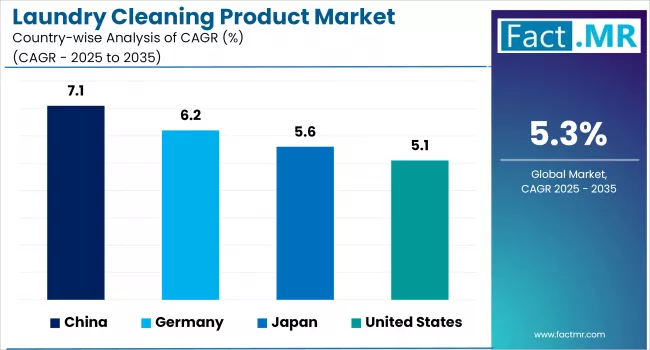
| Country | CAGR (2025-2035) |
|---|---|
| USA | 3.3% |
| Mexico | 3.0% |
| Germany | 2.6% |
| South Korea | 2.6% |
| France | 2.5% |
| UK | 2.4% |
| Japan | 2.3% |
The laundry cleaning product market is gaining momentum worldwide, with the USA taking the lead thanks to strong consumer spending power and established household product retail infrastructure. Close behind, Mexico benefits from rapid urbanization and growing middle-class household formation, positioning itself as a strategic growth hub in the Latin American region. Germany and South Korea show equal advancement, where integration of premium household products strengthens their roles in the European and Asian consumer goods supply chains.
France and the UK demonstrate steady growth momentum, focusing on premium and eco-friendly product innovations, signaling ambitions to capitalize on the growing opportunities in sustainable household product markets. Meanwhile, Japan continues to record consistent progress in advanced laundry technology and concentrated product development. Together, the USA and Mexico anchor the global expansion story, while the rest build stability and diversity into the market's growth path.
The report covers an in-depth analysis of 40+ countries; 7 top-performing countries are highlighted below.
USA Leads Global Market Expansion
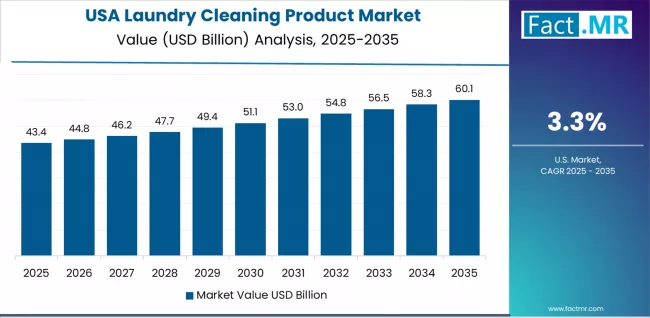
The USA demonstrates the strongest growth potential in the Laundry Cleaning Product Market with a CAGR of 3.3% through 2035. The country's leadership position stems from robust consumer spending power, established retail infrastructure, and strong household product culture driving the adoption of premium liquid detergents and innovative laundry solutions.
Growth is concentrated in major metropolitan areas, including New York, Los Angeles, Chicago, and Houston, where households and commercial facilities are implementing comprehensive laundry care routines and premium cleaning products for enhanced fabric care results. Distribution channels through major grocery chains and big-box retailers expand coverage across suburban and urban markets throughout the country. The country's emphasis on convenience and cleaning efficacy provides sustained demand for laundry innovation, including concentrated formulations and eco-friendly alternatives.
Key market factors:
- Consumer spending expansion concentrated in metropolitan areas and suburban markets with comprehensive retail infrastructure development programs
- Household formation trends through established consumer culture and premium product adoption patterns
- Comprehensive retail ecosystem, including established grocery chains and household product distributors
- Innovation leadership featuring concentrated formulations, eco-friendly initiatives, and premium laundry care capabilities
Mexico Emerges as High-Growth Market
In Mexico City, Guadalajara, Monterrey, and expanding urban centers, the adoption of comprehensive laundry cleaning products is accelerating across growing middle-class households and urbanization trends, driven by increasing disposable income and modern household appliance penetration. The market demonstrates strong growth momentum with a CAGR of 3.0% through 2035, linked to comprehensive economic development and increasing focus on household hygiene standards and fabric care improvement.
Mexican consumers are implementing modern laundry routines and branded cleaning products to enhance household cleanliness while meeting growing lifestyle expectations in expanding urban environments. The country's urbanization trends and demographic advantages create sustained demand for laundry products, while increasing emphasis on household hygiene drives adoption of premium and convenient cleaning solutions.
- Leading urban markets, including Mexico City, Guadalajara, and Monterrey, are driving laundry product adoption
- Economic development models enabling household product retail expansion and modern appliance penetration
- Urbanization advantage trends accelerating adoption with growing middle-class spending and lifestyle modernization
- Demographic benefits through household formation and increasing consumer goods spending patterns
Germany Maintains Household Product Leadership
Germany's established consumer goods sector demonstrates sophisticated implementation of laundry cleaning products, with documented case studies showing 15% increase in premium product adoption through advanced retail channels and eco-friendly product positioning.
The country's retail infrastructure in major cities, including Berlin, Munich, Hamburg, and Frankfurt, showcases integration of traditional household product distribution with modern sustainability technologies, leveraging expertise in environmental responsibility and premium consumer goods.
German consumers emphasize quality and environmental sustainability, creating demand for concentrated laundry products that support eco-friendly household goals and effective fabric care maintenance. The market maintains steady growth through focus on sustainability innovation and premium quality standards, with a CAGR of 2.6% through 2035.
Key development areas:
- Consumer goods retailers and supermarket chains leading sustainable laundry product adoption with comprehensive environmental programs
- Premium quality channels providing integrated solutions with 93% concentrated formulation rates
- Sustainability partnerships between German household product companies and environmental organizations expanding eco-friendly market reach
- Integration of traditional household product quality and modern environmental responsibility standards
Europe Market Split by Country
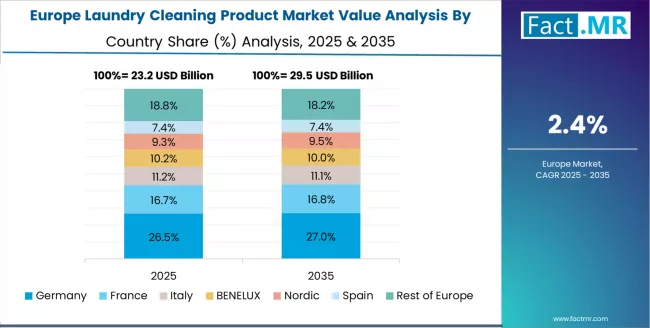
The laundry cleaning product market in Europe is projected to grow from USD 24.5 billion in 2025 to USD 33.0 billion by 2035, registering a CAGR of 3.0% over the forecast period. Germany is expected to maintain its leadership position with a 26.1% market share in 2025, declining slightly to 25.9% by 2035, supported by its strong retail infrastructure, established household product culture, and comprehensive distribution networks serving major European markets.
The United Kingdom follows with a 20.4% share in 2025, projected to reach 20.2% by 2035, driven by comprehensive retail modernization programs in London, Manchester, and other metropolitan areas implementing advanced household product distribution. France holds a 19.4% share in 2025, expected to maintain 19.3% by 2035 through the ongoing development of premium household products and eco-friendly formulations.
Italy commands a 16.3% share, while Spain accounts for 12.2% in 2025. The Rest of Europe region is anticipated to gain momentum, expanding its collective share from 5.6% to 6.3% by 2035, attributed to increasing laundry product adoption in Nordic countries and emerging Eastern European household markets implementing modern cleaning standards.
Competitive Landscape of the Laundry Cleaning Product Market
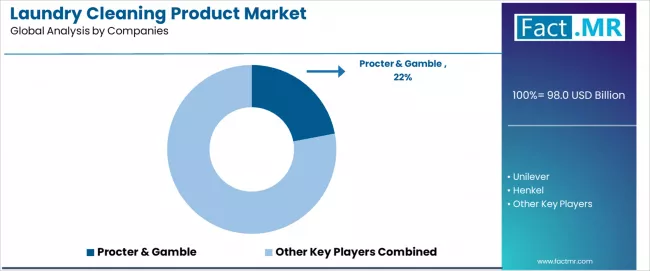
The laundry cleaning product market features approximately 40-50 meaningful players with moderate concentration, where the top three companies control roughly 35-42% of global market share through established brand portfolios and extensive retail distribution relationships. Competition centers on cleaning effectiveness, brand trust, and distribution reach rather than price competition alone.
Market leaders include Procter & Gamble, Unilever, and Henkel, which maintain competitive advantages through comprehensive laundry product portfolios, global retail networks, and deep expertise in consumer goods marketing and household cleaning formulations, creating strong brand loyalty and retail partnership advantages. These companies leverage established consumer relationships and ongoing innovation investments to defend market positions while expanding into adjacent household care categories and emerging market segments.
Challengers encompass Church & Dwight and Kao, which compete through specialized formulations and strong regional presence in key household markets. Consumer goods specialists, including Reckitt, Fabuloso/Colgate, and LG H&H, focus on specific regional markets or product innovations, offering differentiated capabilities in concentrated formulations, premium positioning, and regional consumer preferences.
Regional players and emerging brands create competitive pressure through eco-friendly positioning and specialized formulations, particularly in high-growth markets including Asia-Pacific and Latin America, where local presence provides advantages in cultural understanding and price positioning. Market dynamics favor companies that combine proven cleaning effectiveness with comprehensive retail distribution and established consumer relationships that address the complete household laundry care lifecycle from brand awareness through ongoing consumer loyalty.
Global Laundry Cleaning Product Market - Stakeholder Contribution Framework
Laundry cleaning product solutions represent a critical household necessity that enables consumers, commercial facilities, and institutional operations to maintain fabric hygiene and clothing care standards without requiring specialized equipment or professional services, typically providing enhanced cleaning power, fabric protection, and convenience features compared to basic soap alternatives.
With the market projected to grow from USD 98.0 billion in 2025 to USD 132.0 billion by 2035 at a 3.0% CAGR, these solutions offer compelling advantages - cleaning effectiveness, user convenience, and fabric care - making them essential for household applications (82.0% market share), commercial operations (18.0% share), and diverse institutional laundry requirements seeking reliable cleaning solutions.
Scaling market penetration and sustainability features requires coordinated action across consumer goods policy, environmental standards, laundry product manufacturers, retail distribution networks, and environmental advocacy organizations.
How Governments Could Spur Local Production and Adoption?
- Consumer Goods Development Programs: Include household product manufacturing in national industrial development initiatives, providing targeted support for domestic consumer goods production in underserved regions and supporting local household product companies through manufacturing incentives and infrastructure grants.
- Trade Policy & Environmental Support: Implement favorable treatment for eco-friendly product investments, provide incentives for companies investing in sustainable packaging and biodegradable formulations, and establish environmental standards that encourage green household product adoption over traditional chemical approaches.
- Regulatory Framework Development: Create standardized safety and efficacy processes across household and commercial applications, establish clear ingredient disclosure frameworks for consumer protection, and develop international harmonization protocols that facilitate cross-border household product trade.
- Public Health & Education: Fund consumer education programs for household hygiene practices, sustainable cleaning methods, and product safety awareness. Invest in public health initiatives that bridge hygiene education with effective household product usage and safety protocols.
- Market Access & Competition: Establish procurement policies that support effective cleaning solutions for government facility maintenance, support small and medium household product companies through preferential lending programs, and create regulatory environments that encourage innovation in sustainable cleaning technologies.
How Industry Bodies Could Support Market Development?
- Safety Standards & Certification: Define standardized effectiveness metrics for laundry products across household and commercial applications, establish universal safety and environmental protocols, and create certification programs for product performance that consumers can trust.
- Market Education & Best Practices: Lead messaging that demonstrates laundry product advantages, emphasizing improved cleaning outcomes, fabric protection, and superior convenience compared to basic cleaning alternatives.
- Technology Integration Standards: Develop interoperability standards for product packaging, sustainable formulation guidelines, and retail distribution platforms, ensuring seamless integration across different household environments and consumer preferences.
- Professional Development: Run certification programs for retail teams, product safety specialists, and formulation experts on optimizing product effectiveness, consumer education, and sustainable cleaning practices in competitive retail markets.
How Manufacturers and Technology Players Could Strengthen the Ecosystem?
- Advanced Product Development: Develop next-generation cleaning formulations with enhanced effectiveness capabilities, improved environmental profiles, and convenient packaging features that enhance cleaning performance while maintaining user safety and environmental responsibility.
- Innovation Platforms: Provide comprehensive research capabilities that integrate sustainable ingredients, concentrated formulations, eco-friendly packaging, and consumer convenience features, enabling brands to maximize product effectiveness and environmental positioning.
- Service & Support Networks: Offer flexible support programs for retail partners and consumers, including educational resources, product usage guidance, and sustainability information that keep laundry products relevant to evolving consumer needs.
- Research & Development Networks: Build comprehensive R&D capabilities, collaborative sustainability programs, and consumer insight systems that ensure cleaning technologies maintain superior effectiveness and consistent environmental responsibility across diverse market segments.
How Suppliers Could Navigate the Shift?
- Diversified Product Portfolios: Expand laundry product offerings across liquid formats (46.0% market dominance), powder formulations (33.0% share), and innovative pods/sheets, with particular focus on household applications (82.0% usage share) and sustainable positioning strategies.
- Geographic Market Development: Establish operations in high-growth markets like USA (3.3% CAGR) and Mexico (3.0% CAGR), while strengthening presence in established markets like Germany (2.6% CAGR) and South Korea (2.6% CAGR) through regional manufacturing capabilities and local partnerships.
- Technology-Enabled Services: Implement advanced consumer engagement systems with sustainability education, usage optimization, and effectiveness monitoring capabilities that differentiate service offerings and improve consumer satisfaction and brand loyalty.
- Flexible Product Models: Develop standard, premium, and eco-friendly laundry solutions that accommodate varying consumer needs, from cost-effective household cleaning to specialized products for demanding commercial requirements.
How Investors and Financial Enablers Could Unlock Value?
- Product Portfolio Expansion Financing: Provide growth capital for established companies like Procter & Gamble, Unilever, and Henkel to expand sustainable product portfolios and geographic coverage, particularly in emerging markets with growing household product demands.
- Innovation Investment: Back startups developing advanced cleaning technologies, sustainable packaging solutions, and plant-based formulation systems that enhance laundry industry sustainability and competitive positioning.
- Regional Market Development: Finance market entry and expansion strategies for laundry product companies establishing operations in high-growth regions, supporting localization initiatives that reduce environmental impact while maintaining cleaning effectiveness.
- Consolidation & Scale Opportunities: Support strategic acquisitions and market consolidation that create economies of scale, improve sustainability capabilities, and enhance competitive positioning against fragmented regional household product providers across multiple geographic markets.
Key Players in the Laundry Cleaning Product Market
- Procter & Gamble
- Unilever
- Henkel
- Church & Dwight
- Kao
- Reckitt
- Fabuloso/Colgate
- LG H&H
- Godrej
- Lion
Scope of the Report
| Item | Value |
|---|---|
| Quantitative Units | USD 98.0 Billion |
| Format | Liquids, Powders, Pods/Sheets, Others |
| Distribution Channel | Mass/Grocery Retail, Online Platforms, Cash & Carry/Others |
| Usage Type | Household, Commercial/Institutional |
| Regions Covered | Asia-Pacific, North America, Europe, Latin America, Middle East & Africa |
| Country Covered | USA, Mexico, Germany, South Korea, France, UK, Japan, and 40+ countries |
| Key Companies Profiled | Procter & Gamble, Unilever, Henkel, Church & Dwight, Kao, Reckitt, Fabuloso/Colgate, LG H&H, Godrej, Lion |
| Additional Attributes | Dollar sales by format and usage type categories, regional adoption trends across Asia-Pacific, North America, and Europe, competitive landscape with household product manufacturers and retail partners, consumer behavior patterns and preferences, integration with sustainability initiatives and eco-friendly formulations, innovations in cleaning technology and concentrated formulations, and development of specialized applications with convenience features and environmental responsibility. |
Laundry Cleaning Product Market by Segments
-
Format :
- Liquids
- Powders
- Pods/Sheets
- Others
-
Distribution Channel :
- Mass/Grocery Retail
- Online Platforms
- Cash & Carry/Others
-
Usage Type :
- Household
- Commercial/Institutional
-
Region :
- Asia-Pacific
- China
- Japan
- South Korea
- India
- Australia & New Zealand
- ASEAN
- Rest of Asia Pacific
- North America
- United States
- Canada
- Mexico
- Europe
- Germany
- United Kingdom
- France
- Italy
- Spain
- Nordic
- BENELUX
- Rest of Europe
- Latin America
- Brazil
- Chile
- Rest of Latin America
- Middle East & Africa
- Kingdom of Saudi Arabia
- Other GCC Countries
- Turkey
- South Africa
- Other African Union
- Rest of Middle East & Africa
- Asia-Pacific
Table of Content
- Executive Summary
- Global Market Outlook
- Demand to side Trends
- Supply to side Trends
- Technology Roadmap Analysis
- Analysis and Recommendations
- Market Overview
- Market Coverage / Taxonomy
- Market Definition / Scope / Limitations
- Market Background
- Market Dynamics
- Drivers
- Restraints
- Opportunity
- Trends
- Scenario Forecast
- Demand in Optimistic Scenario
- Demand in Likely Scenario
- Demand in Conservative Scenario
- Opportunity Map Analysis
- Product Life Cycle Analysis
- Supply Chain Analysis
- Investment Feasibility Matrix
- Value Chain Analysis
- PESTLE and Porter’s Analysis
- Regulatory Landscape
- Regional Parent Market Outlook
- Production and Consumption Statistics
- Import and Export Statistics
- Market Dynamics
- Global Market Analysis 2020 to 2024 and Forecast, 2025 to 2035
- Historical Market Size Value (USD Million) Analysis, 2020 to 2024
- Current and Future Market Size Value (USD Million) Projections, 2025 to 2035
- Y to o to Y Growth Trend Analysis
- Absolute $ Opportunity Analysis
- Global Market Pricing Analysis 2020 to 2024 and Forecast 2025 to 2035
- Global Market Analysis 2020 to 2024 and Forecast 2025 to 2035, By Format
- Introduction / Key Findings
- Historical Market Size Value (USD Million) Analysis By Format , 2020 to 2024
- Current and Future Market Size Value (USD Million) Analysis and Forecast By Format , 2025 to 2035
- Liquids
- Powders
- Pods/Sheets
- Others
- Y to o to Y Growth Trend Analysis By Format , 2020 to 2024
- Absolute $ Opportunity Analysis By Format , 2025 to 2035
- Global Market Analysis 2020 to 2024 and Forecast 2025 to 2035, By Usage Type
- Introduction / Key Findings
- Historical Market Size Value (USD Million) Analysis By Usage Type, 2020 to 2024
- Current and Future Market Size Value (USD Million) Analysis and Forecast By Usage Type, 2025 to 2035
- Household
- Commercial/Institutional
- Y to o to Y Growth Trend Analysis By Usage Type, 2020 to 2024
- Absolute $ Opportunity Analysis By Usage Type, 2025 to 2035
- Global Market Analysis 2020 to 2024 and Forecast 2025 to 2035, By Region
- Introduction
- Historical Market Size Value (USD Million) Analysis By Region, 2020 to 2024
- Current Market Size Value (USD Million) Analysis and Forecast By Region, 2025 to 2035
- North America
- Latin America
- Western Europe
- Eastern Europe
- East Asia
- South Asia and Pacific
- Middle East & Africa
- Market Attractiveness Analysis By Region
- North America Market Analysis 2020 to 2024 and Forecast 2025 to 2035, By Country
- Historical Market Size Value (USD Million) Trend Analysis By Market Taxonomy, 2020 to 2024
- Market Size Value (USD Million) Forecast By Market Taxonomy, 2025 to 2035
- By Country
- USA
- Canada
- Mexico
- By Format
- By Usage Type
- By Country
- Market Attractiveness Analysis
- By Country
- By Format
- By Usage Type
- Key Takeaways
- Latin America Market Analysis 2020 to 2024 and Forecast 2025 to 2035, By Country
- Historical Market Size Value (USD Million) Trend Analysis By Market Taxonomy, 2020 to 2024
- Market Size Value (USD Million) Forecast By Market Taxonomy, 2025 to 2035
- By Country
- Brazil
- Chile
- Rest of Latin America
- By Format
- By Usage Type
- By Country
- Market Attractiveness Analysis
- By Country
- By Format
- By Usage Type
- Key Takeaways
- Western Europe Market Analysis 2020 to 2024 and Forecast 2025 to 2035, By Country
- Historical Market Size Value (USD Million) Trend Analysis By Market Taxonomy, 2020 to 2024
- Market Size Value (USD Million) Forecast By Market Taxonomy, 2025 to 2035
- By Country
- Germany
- UK
- Italy
- Spain
- France
- Nordic
- BENELUX
- Rest of Western Europe
- By Format
- By Usage Type
- By Country
- Market Attractiveness Analysis
- By Country
- By Format
- By Usage Type
- Key Takeaways
- Eastern Europe Market Analysis 2020 to 2024 and Forecast 2025 to 2035, By Country
- Historical Market Size Value (USD Million) Trend Analysis By Market Taxonomy, 2020 to 2024
- Market Size Value (USD Million) Forecast By Market Taxonomy, 2025 to 2035
- By Country
- Russia
- Poland
- Hungary
- Balkan & Baltic
- Rest of Eastern Europe
- By Format
- By Usage Type
- By Country
- Market Attractiveness Analysis
- By Country
- By Format
- By Usage Type
- Key Takeaways
- East Asia Market Analysis 2020 to 2024 and Forecast 2025 to 2035, By Country
- Historical Market Size Value (USD Million) Trend Analysis By Market Taxonomy, 2020 to 2024
- Market Size Value (USD Million) Forecast By Market Taxonomy, 2025 to 2035
- By Country
- China
- Japan
- South Korea
- By Format
- By Usage Type
- By Country
- Market Attractiveness Analysis
- By Country
- By Format
- By Usage Type
- Key Takeaways
- South Asia and Pacific Market Analysis 2020 to 2024 and Forecast 2025 to 2035, By Country
- Historical Market Size Value (USD Million) Trend Analysis By Market Taxonomy, 2020 to 2024
- Market Size Value (USD Million) Forecast By Market Taxonomy, 2025 to 2035
- By Country
- India
- ASEAN
- Australia & New Zealand
- Rest of South Asia and Pacific
- By Format
- By Usage Type
- By Country
- Market Attractiveness Analysis
- By Country
- By Format
- By Usage Type
- Key Takeaways
- Middle East & Africa Market Analysis 2020 to 2024 and Forecast 2025 to 2035, By Country
- Historical Market Size Value (USD Million) Trend Analysis By Market Taxonomy, 2020 to 2024
- Market Size Value (USD Million) Forecast By Market Taxonomy, 2025 to 2035
- By Country
- Kingdom of Saudi Arabia
- Other GCC Countries
- Turkiye
- South Africa
- Other African Union
- Rest of Middle East & Africa
- By Format
- By Usage Type
- By Country
- Market Attractiveness Analysis
- By Country
- By Format
- By Usage Type
- Key Takeaways
- Key Countries Market Analysis
- USA
- Pricing Analysis
- Market Share Analysis, 2024
- By Format
- By Usage Type
- Canada
- Pricing Analysis
- Market Share Analysis, 2024
- By Format
- By Usage Type
- Mexico
- Pricing Analysis
- Market Share Analysis, 2024
- By Format
- By Usage Type
- Brazil
- Pricing Analysis
- Market Share Analysis, 2024
- By Format
- By Usage Type
- Chile
- Pricing Analysis
- Market Share Analysis, 2024
- By Format
- By Usage Type
- Germany
- Pricing Analysis
- Market Share Analysis, 2024
- By Format
- By Usage Type
- UK
- Pricing Analysis
- Market Share Analysis, 2024
- By Format
- By Usage Type
- Italy
- Pricing Analysis
- Market Share Analysis, 2024
- By Format
- By Usage Type
- Spain
- Pricing Analysis
- Market Share Analysis, 2024
- By Format
- By Usage Type
- France
- Pricing Analysis
- Market Share Analysis, 2024
- By Format
- By Usage Type
- India
- Pricing Analysis
- Market Share Analysis, 2024
- By Format
- By Usage Type
- ASEAN
- Pricing Analysis
- Market Share Analysis, 2024
- By Format
- By Usage Type
- Australia & New Zealand
- Pricing Analysis
- Market Share Analysis, 2024
- By Format
- By Usage Type
- China
- Pricing Analysis
- Market Share Analysis, 2024
- By Format
- By Usage Type
- Japan
- Pricing Analysis
- Market Share Analysis, 2024
- By Format
- By Usage Type
- South Korea
- Pricing Analysis
- Market Share Analysis, 2024
- By Format
- By Usage Type
- Russia
- Pricing Analysis
- Market Share Analysis, 2024
- By Format
- By Usage Type
- Poland
- Pricing Analysis
- Market Share Analysis, 2024
- By Format
- By Usage Type
- Hungary
- Pricing Analysis
- Market Share Analysis, 2024
- By Format
- By Usage Type
- Kingdom of Saudi Arabia
- Pricing Analysis
- Market Share Analysis, 2024
- By Format
- By Usage Type
- Turkiye
- Pricing Analysis
- Market Share Analysis, 2024
- By Format
- By Usage Type
- South Africa
- Pricing Analysis
- Market Share Analysis, 2024
- By Format
- By Usage Type
- USA
- Market Structure Analysis
- Competition Dashboard
- Competition Benchmarking
- Market Share Analysis of Top Players
- By Regional
- By Format
- By Usage Type
- Competition Analysis
- Competition Deep Dive
- Procter & Gamble
- Overview
- Product Portfolio
- Profitability by Market Segments (Product/Age /Sales Channel/Region)
- Sales Footprint
- Strategy Overview
- Marketing Strategy
- Product Strategy
- Channel Strategy
- Unilever
- Henkel
- Church & Dwight
- Kao
- Reckitt
- Fabuloso/Colgate
- LG H&H
- Godrej
- Lion
- Procter & Gamble
- Competition Deep Dive
- Assumptions & Acronyms Used
- Research Methodology
List Of Table
- Table 1: Global Market Value (USD Million) Forecast by Region, 2020 to 2035
- Table 2: Global Market Value (USD Million) Forecast by Format , 2020 to 2035
- Table 3: Global Market Value (USD Million) Forecast by Usage Type, 2020 to 2035
- Table 4: North America Market Value (USD Million) Forecast by Country, 2020 to 2035
- Table 5: North America Market Value (USD Million) Forecast by Format , 2020 to 2035
- Table 6: North America Market Value (USD Million) Forecast by Usage Type, 2020 to 2035
- Table 7: Latin America Market Value (USD Million) Forecast by Country, 2020 to 2035
- Table 8: Latin America Market Value (USD Million) Forecast by Format , 2020 to 2035
- Table 9: Latin America Market Value (USD Million) Forecast by Usage Type, 2020 to 2035
- Table 10: Western Europe Market Value (USD Million) Forecast by Country, 2020 to 2035
- Table 11: Western Europe Market Value (USD Million) Forecast by Format , 2020 to 2035
- Table 12: Western Europe Market Value (USD Million) Forecast by Usage Type, 2020 to 2035
- Table 13: Eastern Europe Market Value (USD Million) Forecast by Country, 2020 to 2035
- Table 14: Eastern Europe Market Value (USD Million) Forecast by Format , 2020 to 2035
- Table 15: Eastern Europe Market Value (USD Million) Forecast by Usage Type, 2020 to 2035
- Table 16: East Asia Market Value (USD Million) Forecast by Country, 2020 to 2035
- Table 17: East Asia Market Value (USD Million) Forecast by Format , 2020 to 2035
- Table 18: East Asia Market Value (USD Million) Forecast by Usage Type, 2020 to 2035
- Table 19: South Asia and Pacific Market Value (USD Million) Forecast by Country, 2020 to 2035
- Table 20: South Asia and Pacific Market Value (USD Million) Forecast by Format , 2020 to 2035
- Table 21: South Asia and Pacific Market Value (USD Million) Forecast by Usage Type, 2020 to 2035
- Table 22: Middle East & Africa Market Value (USD Million) Forecast by Country, 2020 to 2035
- Table 23: Middle East & Africa Market Value (USD Million) Forecast by Format , 2020 to 2035
- Table 24: Middle East & Africa Market Value (USD Million) Forecast by Usage Type, 2020 to 2035
List Of Figures
- Figure 1: Global Market Pricing Analysis
- Figure 2: Global Market Value (USD Million) Forecast 2020-2035
- Figure 3: Global Market Value Share and BPS Analysis by Format , 2025 and 2035
- Figure 4: Global Market Y to o to Y Growth Comparison by Format , 2025-2035
- Figure 5: Global Market Attractiveness Analysis by Format
- Figure 6: Global Market Value Share and BPS Analysis by Usage Type, 2025 and 2035
- Figure 7: Global Market Y to o to Y Growth Comparison by Usage Type, 2025-2035
- Figure 8: Global Market Attractiveness Analysis by Usage Type
- Figure 9: Global Market Value (USD Million) Share and BPS Analysis by Region, 2025 and 2035
- Figure 10: Global Market Y to o to Y Growth Comparison by Region, 2025-2035
- Figure 11: Global Market Attractiveness Analysis by Region
- Figure 12: North America Market Incremental Dollar Opportunity, 2025-2035
- Figure 13: Latin America Market Incremental Dollar Opportunity, 2025-2035
- Figure 14: Western Europe Market Incremental Dollar Opportunity, 2025-2035
- Figure 15: Eastern Europe Market Incremental Dollar Opportunity, 2025-2035
- Figure 16: East Asia Market Incremental Dollar Opportunity, 2025-2035
- Figure 17: South Asia and Pacific Market Incremental Dollar Opportunity, 2025-2035
- Figure 18: Middle East & Africa Market Incremental Dollar Opportunity, 2025-2035
- Figure 19: North America Market Value Share and BPS Analysis by Country, 2025 and 2035
- Figure 20: North America Market Value Share and BPS Analysis by Format , 2025 and 2035
- Figure 21: North America Market Y to o to Y Growth Comparison by Format , 2025-2035
- Figure 22: North America Market Attractiveness Analysis by Format
- Figure 23: North America Market Value Share and BPS Analysis by Usage Type, 2025 and 2035
- Figure 24: North America Market Y to o to Y Growth Comparison by Usage Type, 2025-2035
- Figure 25: North America Market Attractiveness Analysis by Usage Type
- Figure 26: Latin America Market Value Share and BPS Analysis by Country, 2025 and 2035
- Figure 27: Latin America Market Value Share and BPS Analysis by Format , 2025 and 2035
- Figure 28: Latin America Market Y to o to Y Growth Comparison by Format , 2025-2035
- Figure 29: Latin America Market Attractiveness Analysis by Format
- Figure 30: Latin America Market Value Share and BPS Analysis by Usage Type, 2025 and 2035
- Figure 31: Latin America Market Y to o to Y Growth Comparison by Usage Type, 2025-2035
- Figure 32: Latin America Market Attractiveness Analysis by Usage Type
- Figure 33: Western Europe Market Value Share and BPS Analysis by Country, 2025 and 2035
- Figure 34: Western Europe Market Value Share and BPS Analysis by Format , 2025 and 2035
- Figure 35: Western Europe Market Y to o to Y Growth Comparison by Format , 2025-2035
- Figure 36: Western Europe Market Attractiveness Analysis by Format
- Figure 37: Western Europe Market Value Share and BPS Analysis by Usage Type, 2025 and 2035
- Figure 38: Western Europe Market Y to o to Y Growth Comparison by Usage Type, 2025-2035
- Figure 39: Western Europe Market Attractiveness Analysis by Usage Type
- Figure 40: Eastern Europe Market Value Share and BPS Analysis by Country, 2025 and 2035
- Figure 41: Eastern Europe Market Value Share and BPS Analysis by Format , 2025 and 2035
- Figure 42: Eastern Europe Market Y to o to Y Growth Comparison by Format , 2025-2035
- Figure 43: Eastern Europe Market Attractiveness Analysis by Format
- Figure 44: Eastern Europe Market Value Share and BPS Analysis by Usage Type, 2025 and 2035
- Figure 45: Eastern Europe Market Y to o to Y Growth Comparison by Usage Type, 2025-2035
- Figure 46: Eastern Europe Market Attractiveness Analysis by Usage Type
- Figure 47: East Asia Market Value Share and BPS Analysis by Country, 2025 and 2035
- Figure 48: East Asia Market Value Share and BPS Analysis by Format , 2025 and 2035
- Figure 49: East Asia Market Y to o to Y Growth Comparison by Format , 2025-2035
- Figure 50: East Asia Market Attractiveness Analysis by Format
- Figure 51: East Asia Market Value Share and BPS Analysis by Usage Type, 2025 and 2035
- Figure 52: East Asia Market Y to o to Y Growth Comparison by Usage Type, 2025-2035
- Figure 53: East Asia Market Attractiveness Analysis by Usage Type
- Figure 54: South Asia and Pacific Market Value Share and BPS Analysis by Country, 2025 and 2035
- Figure 55: South Asia and Pacific Market Value Share and BPS Analysis by Format , 2025 and 2035
- Figure 56: South Asia and Pacific Market Y to o to Y Growth Comparison by Format , 2025-2035
- Figure 57: South Asia and Pacific Market Attractiveness Analysis by Format
- Figure 58: South Asia and Pacific Market Value Share and BPS Analysis by Usage Type, 2025 and 2035
- Figure 59: South Asia and Pacific Market Y to o to Y Growth Comparison by Usage Type, 2025-2035
- Figure 60: South Asia and Pacific Market Attractiveness Analysis by Usage Type
- Figure 61: Middle East & Africa Market Value Share and BPS Analysis by Country, 2025 and 2035
- Figure 62: Middle East & Africa Market Value Share and BPS Analysis by Format , 2025 and 2035
- Figure 63: Middle East & Africa Market Y to o to Y Growth Comparison by Format , 2025-2035
- Figure 64: Middle East & Africa Market Attractiveness Analysis by Format
- Figure 65: Middle East & Africa Market Value Share and BPS Analysis by Usage Type, 2025 and 2035
- Figure 66: Middle East & Africa Market Y to o to Y Growth Comparison by Usage Type, 2025-2035
- Figure 67: Middle East & Africa Market Attractiveness Analysis by Usage Type
- Figure 68: Global Market - Tier Structure Analysis
- Figure 69: Global Market - Company Share Analysis
- FAQs -
How big is the laundry cleaning product market in 2025?
The global laundry cleaning product market is estimated to be valued at USD 98.0 billion in 2025.
What will be the size of laundry cleaning product market in 2035?
The market size for the laundry cleaning product market is projected to reach USD 131.7 billion by 2035.
How much will be the laundry cleaning product market growth between 2025 and 2035?
The laundry cleaning product market is expected to grow at a 3.0% CAGR between 2025 and 2035.
What are the key product types in the laundry cleaning product market?
The key product types in laundry cleaning product market are liquids, powders, pods/sheets and others.
Which usage type segment to contribute significant share in the laundry cleaning product market in 2025?
In terms of usage type, household segment to command 82.0% share in the laundry cleaning product market in 2025.